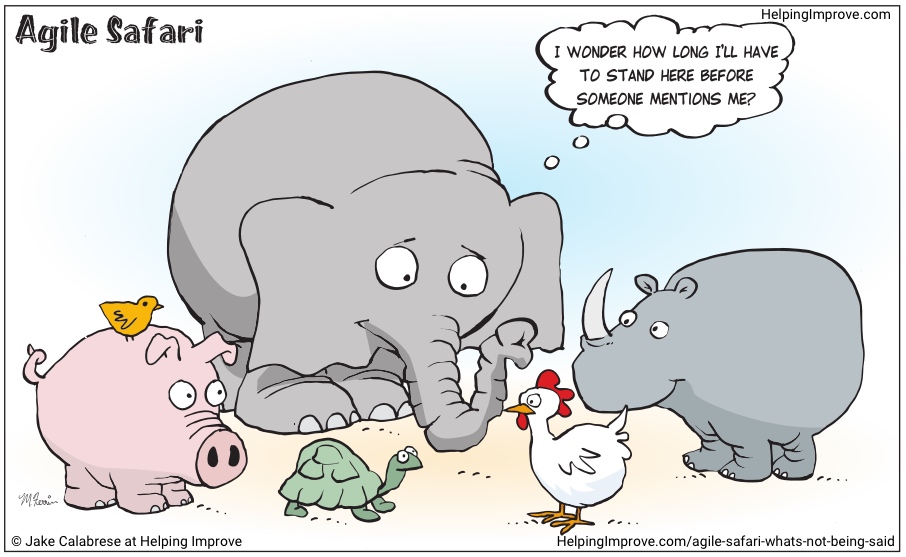
Have you been in a situation where no one would bring up the problem that everyone knew was “in the room?” I’d guess that everyone has been there. So often, we don’t bring up the “elephant in the room.” For anyone who has not heard of this, the elephant in the room is a saying for the real or obvious truth that is not being addressed. Given an elephant in a room would be hard to miss, when people ignore it, they are typically pretending it is not there.
Consider a situation where you did this or observed a team or group pretending a problem was not there. What was really happening? Why were people avoiding the issue? Tweet the Agile Safari Cartoon!
I remember a few years back, I was working with a product team as an agile coach. It was my second day working with them and after the first day, I knew something had to give. I asked my kids for a stuffed animal elephant (they thought it was funny, back then, that I was bringing stuffed animals to work) and brought it in. I pulled up an extra chair at the meeting and sat the elephant in the chair. I did not say anything about it. I just started the meeting. I don’t know how long it took, maybe 20 minutes, until someone got up, walked over and picked it up and said — I want to talk about this! It did not solve every issue immediately, but it did start the conversation! If you did this with a group at your organization, how long would it take for people to bring up an issue? How long would it take for someone to pick up the elephant?
What Is The Elephant in the Room?
When we think about the idea of the elephant in the room — and as the saying goes — it is an obvious issue. While I tend to agree, realize that the core issue may be obvious, but the solution or reasons for it may not be. Each person involved may have a different perception of the issue. That is important to realize as the issue comes up. You may want to use a tool or some approach to structure the discussion, like The Focused Conversation or a retrospective format.
How Big Is the Elephant?
Another premise about the elephant in the room is that it is very big and impossible to miss. As I was working on this cartoon, I realized that the size of the elephant might vary based on the perception of each individual. That does not mean it should not be discussed, but it is another idea to consider when working with a team or group of people. Some people may see “the elephant” as a bigger issue than others — so ensuring everyone’s voice is heard is important.
Does the Elephant Want to be Discussed?
I think this is an interesting way of looking at things — which the cartoon highlights. This may sound a bit odd, but if you stepped into the elephants ‘shoes’ for a minute, what would that be like? I can image the elephant is sad, bored, and anxious about when or if the team will discuss him (the problem)! “When will they talk about me?”, I imagine the elephant wondering! Don’t make the elephant sad! Talk about the issues and problems that exist! Everyone knows it! Just bring them up, in a respectful way, or ask for some help if you are not comfortable doing that. You might look at the articles on team toxins for few ideas. Read this great article by Allison Pollard , Providing Safety as a Coach, Facilitator, or Scrum Master, which brings up the critical topic of safety. Realize that lack of safety may be a major factor in people avoiding the elephant — just because YOU feel safe, does not mean everyone does.
For agile to work. . . to increase agility in our organizations. . . we need to be working together and truly collaborating! We need to be working to build antifragile relationships and teams. If we are not able to communicate, we are stuck — how can we have trust or respect when we can’t communicate? Ask for help, check out some of the articles I mentioned here, and/or hire a coach to help if the issues are really challenging (or if you do not feel comfortable or safe in bringing issues up). You may also just print out the cartoon and give a copy to everyone on the team — then have each person write the biggest issue the team is facing on the elephants back and lay them out for everyone to see. Then look to a retrospective format to generate ideas to tackle them.
Tweet Agile Safari Cartoon (with the image) if you like it or read the next Agile Safari cartoon].









Jake – a wonderful cartoon with so much depth! I love your idea of taking the stuffed elephant into the room and seeing who would speak to it. The conversation could then go in so many ways. I also see a lot of value in having the cartoon printed out and having each person name what they believe the elephant is. What a rich harvest of information about the system that could bring up!
Rosalie, this was an interesting one, as I got into it – so many dimensions or ways to go as you say! Thanks for the comment!
Excellent Jake. Creating transparency is fundamental to Agile, so, we need to make the Elephants visible, also. What a fun and concrete way of doing so.
John, thanks! There certainly are too many invisible elephants walking around inside of offices…
Jake,
I too love your idea of bringing the stuffed elephant to the meeting. As a coach I’ve often probed to see if there was anyone who wanted to get the “elephant out”, to met with down turned eyes and silence. LOL. Perhaps a real elephant might have helped!!
Henry, it sure might. It is interesting how sometimes a toy or stuffed animal can make things seem easier or more obvious. 🙂 Thanks for your comment!